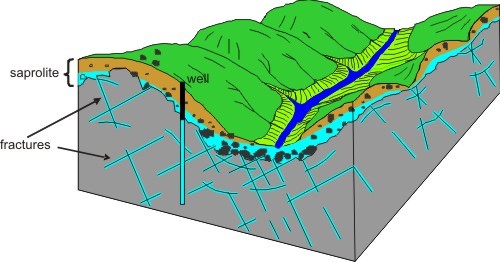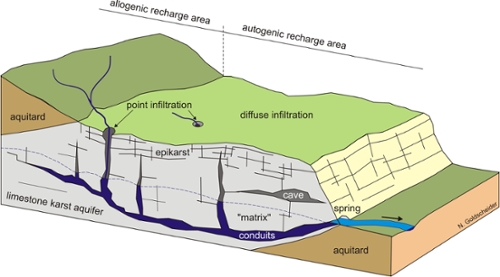Hydrogeologic Settings | Field Camp
Clemson University - Piedmont physiographic province
The home base for most of our field exercises is the campus and university-owned land held by Clemson University. We are located in the Piedmont physiographic province, and the rocks are primarily metamorphic with igneous intrusions. This geologic setting results in a fractured, crystalline-bedrock hydrogeologic framework (Figure 1). We have two wellfields situated in this framework: one immediately adjacent to a prominent creek and the other situated on a groundwater divide. The wellfield next to the creek has six wells with one screened in the saprolite and the other five completed as open hole to a depth of 200'. An open hole completion means that the well is cased (sealed) down to bedrock and then open to the bottom (no casing or screens). The upper wellfield has three wells, with one completed in the saprolite and the other two are open hole completions.

Figure 1. A generalized rendition of a fractured bedrock aquifer. Modified from Heath, Ralph C., 1984, Groundwater regions of the United States, USGS WSP 2242.
We also maintain a wellfield in a shallow (30'-40') deep alluvial aquifer at which we conduct permeable media aquifer tests. These unconsolidated sediments overlie the crystalline bedrock. This wellfield is immediately adjacent to campus and is in the floodplain of the Seneca River. The shallow depth of the aquifer allows us to install monitoring wells with our departmental Geoprobe and by hand. We have six wells screened in the sediments with a drilling rig and numerous wells installed with our Geoprobe.
We spend a week away from the Clemson area in Tennessee and Kentucky examining sedimentary aquifer systems. We utilize the University of Tennessee's wellfield to conduct aquifer tests in a shallow alluvial aquifer underlain by tilted rocks of the Valley and Ridge (Figure 2) physiographic province. The UT field site has approximately 40 feet of alluvium overlying fractured shale bedrock. There are twelve wells at the site, with three screened in the surficial silts, five screened in a semi-confined sand aquifer, one in a basal clay layer, and three in the bedrock.

Figure 2. Hydrogeologic regime of the Valley and Ridge
We examine surface and subsurface karst features in and around Mammoth Cave National Park in Kentucky that control the flow in and out of the cave systems that underlie the area (Figure 3). Students are exposed to the complexities and challenges of characterizing a karst system.

Figure 3. Karst aquifer showing groundwater recharge and discharge (used with permission; from Goldscheider, Nico, and Drew, David, 2007, Methods in Karst Hydrogeology, in International Contributions to Hydrogeology 26, Taylor and Francis, London, UK)


